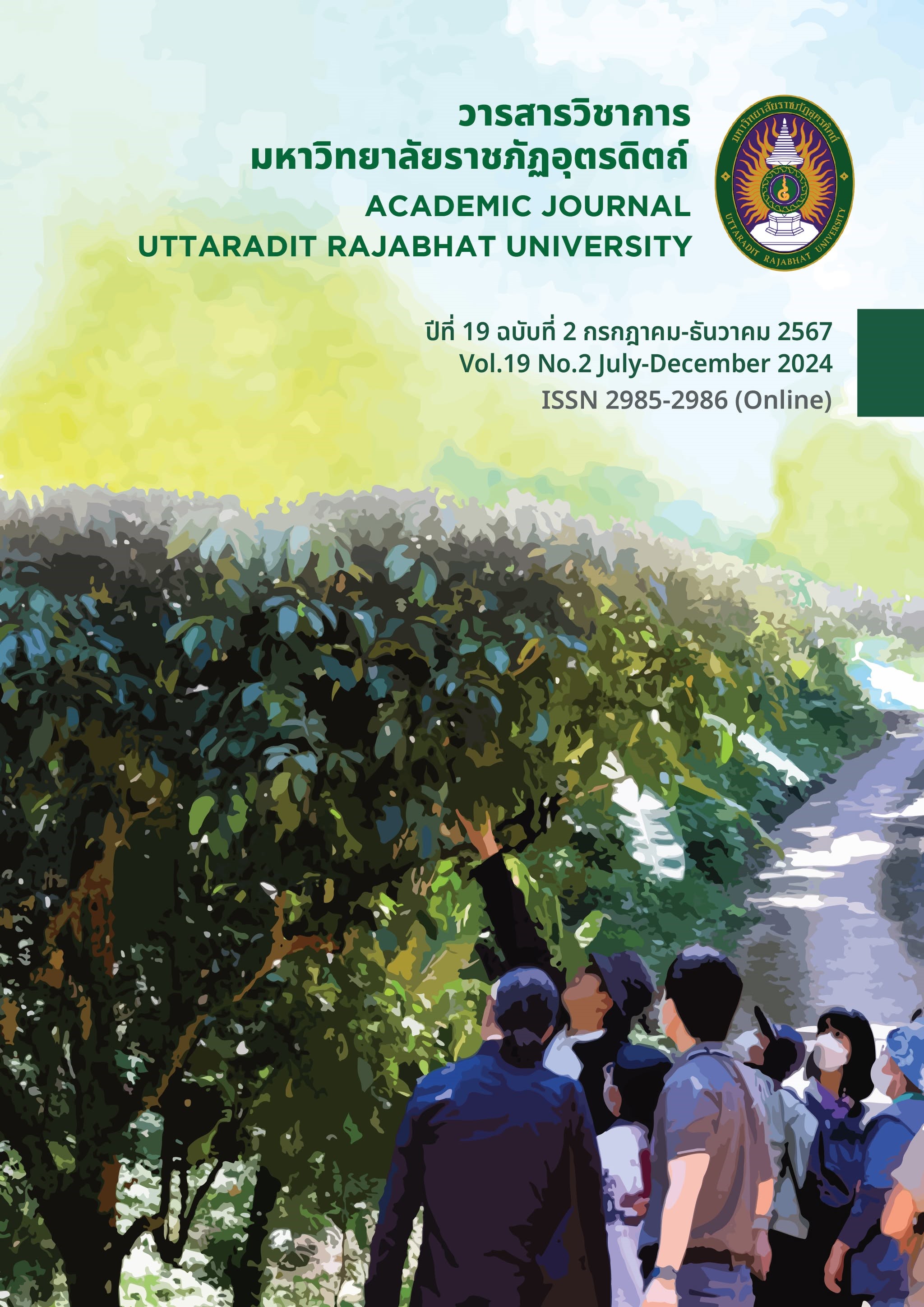THE DEVELOPMENT URGENT DECISION MODEL FOR READY MIXED CONCRET TRUCK ACCIDENT BY USING MACHINE LEARNING TECHNIQUES
Main Article Content
Abstract
The objectives of this research were to develop urgent decision model for ready mixed concrete truck accident, to test the efficiency of urgent decision model for ready mixed concrete truck accident, and to evaluate urgent decision model for ready mixed concrete truck accident. The data used in this study was collected from the information about accidents involving ready mixed concrete transport truck in one location of incidents of establishments in the Khlong Sam Wa Area in Bangkok, which included incidents from 2019 to 2020 in total of 1,000 items. Evaluation of the urgent decision model for ready mixed concrete truck accident was performed by using the sample of establishments in the Minburi and Khlong Sam Wa Areas in Bangkok with purposive selection to obtain 40 establishments that met the criteria. The research tools used were interview forms, questionnaires, and machine learning techniques. The results from synthesizing the factors were used to create a model for urgent decision model in ready mixed concrete truck accident using machine learning. The results revealed that the UDM Model was developed, and the model consisted of problem identification, severity assessment, information notification, process, solution, action and assessment. Efficiency testing of urgent decision model in ready mixed concrete truck accident using machine learning techniques with an Artificial Neuron Network split learning method into training for 70 percent and test for 30 percent with the highest accuracy of 89.52 %. The learning ability of the system users who were able to use the system well by themselves was at a highest level of 75%. As for the ability to recognize the use of the system users, the users could easily remember the form and method of using the system at a high level of 55%. As for system performance, it could help solve users’ problems at a highest level of 75%. As for system errors, there were no errors found, and it was found at a highest level of 60 %. The overall satisfaction of all users of the system was at a highest level of 70 %. The results could be used to reduce delays in solving problems that might occur, resulting in undamaged ready mixed concrete which could be able to be delivered on time. And it could be applied to in transportation of fuel and raw materials to production plants punctually.
Downloads
Article Details

This work is licensed under a Creative Commons Attribution-NonCommercial-NoDerivatives 4.0 International License.
References
กมลรัตน์ สมใจ. (2563, 6-7 กุมภาพันธ์). การเปรียบเทียบประสิทธิภาพโมเดลตัดสินใจเลือกกลุ่มวิชาของนักศึกษาสาขาวิชาเทคโนโลยีสารสนเทศ คณะวิทยาศาสตร์ มหาวิทยาลัยราชภัฏบุรีรัมย์ [การนำเสนอโปสเตอร์]. การประชุมวิชาการระดับชาติด้านวิทยาศาสตร์และเทคโนโลยีเครือข่ายสถาบันอุดมศึกษาภาคใต้ ครั้งที่ 5 “วิทยาศาสตร์ เทคโนโลยี และนวัตกรรมเพื่อสังคม”, คณะวิทยาศาสตร์และเทคโนโลยี มหาวิทยาลัยเทคโนโลยีราชมงคลศรีวิชัย.
กีรติญา ครองแก้ว และวรรณโกมล สุภาชาติ. (2566, 27 มิถุนายน). อุตสาหกรรมวัสดุก่อสร้างปี 2023 เติบโตต่อเนื่องตามภาคก่อสร้าง ท่ามกลางความผันผวนของต้นทุนพลังงาน และแรงกดดันจากเทรนด์ ESG. SCB Economic Intelligence Center. https://www.scbeic.com/th/detail/product/building_materials-270623
บัญชา ปล้องอ้วน, นัฐพงศ์ ส่งเนียม, และชัญญพัชร์ จารุวัชรเศรษฐ์. (2561, 2-5 ธันวาคม). การศึกษาสภาพปัญหาการตัดสินใจแบบเร่งด่วนของงานขนส่งคอนกรีตผสมเสร็จ. การประชุมวิชาการระดับนานาชาติและระดับชาติ“ราชภัฏวิจัยครั้งที่ 5”, (น.619-624). สถาบันวิจัยและส่งเสริมศิลปวัฒนธรรม มหาวิทยาลัยราชภัฏเพชรบุรี.
ราธส จิรวัฒน์สถิต. (2562). ตัวแบบการตัดสินใจในการคัดเลือกจุดกระจายสัญญาณสำหรับโครงข่ายใยแก้วนำแสง [วิทยานิพนธ์ปริญญาเอก, มหาวิทยาลัยราชภัฎพระนคร]. https://lib.pnru.ac.th/cgi-bin/koha/opac-search.pl?q=au:%22%22
สุทธิพันธ์ บุญศรี. (2559). การจัดการการขนส่งคอนกรีตในพื้นที่กรุงเทพกลางเมือง: กรณีศึกษา บริษัทนครหลวงคอนกรีตจำกัด. Journal of logistics and supply chain management Ramkhamhaeng, 3(1).
อัจฉรา ช่องผม และกุลณัฐ ทิพย์ขุนทด. (2562). การลดความล่าช้าในการขนส่งของรถคอนกรีตผสมเสร็จ กรณีศึกษา บริษัทผลิตภัณฑ์และวัสดุก่อสร้าง CPAC จังหวัดสมุทรสาคร. วารสารบริหารธุรกิจอุตสาหกรรม, 1(2), 16-35.
ACI, C., & OZDEN, C. (2018). Predicting the severity of motor vehicle accident injuries in Adana-Turkey using machine learning methods and detailed meteorological data. International Journal of Intelligent Systems and Applications in Engineering, 6(1), 72–79. https://doi.org/10.18201/ijisae.2018637934
Ahsan, M. M., Mahmud, M. A. P., Saha, P. K., Gupta, K. D., & Siddiqu, Z. (2021). Effect of data scaling methods on machine learning algorithms and model performance. Technologies, 9(3). https://doi.org/10.3390/technologies9030052
Bansal, M., Goyal, A., & Choudhary, A. (2022) A comparative analysis of K-Nearest Neighbor, Genetic, Support Vector Machine, Decision Tree, and Long Short Term Memory algorithms in machine learning. Decision Analytics Journal, 3. https://doi.org/10.1016/j.dajour.2022.100071
Cheraghi, Y., Kord, S., & Mashayekhizadeh, V. (2021). Application of machine learning techniques for selecting the most suitable enhanced oil recovery method; challenges and opportunities. Journal of Petroleum Science and Engineering, 205. https://doi.org/10.1016/j.petrol.2021.108761
Hodgett, R. E., & Siraj, S. (2019). SURE: A method for decision-making under uncertainty. Expert Systems with Applications, 115, 684-694. https://doi.org/10.1016/j.eswa.2018.08.048
Liu, Xiao-huan., Zang, De-gan., Yan, Hao-ran., Cui, Yu-ya., & Chen, L. (2019). A New Algorithm of the Best Path Selection Based on Machine Learning. IEEE Access, 7, 126913-126928. https://doi.org/10.1109/ACCESS.2019.2939423
Osisanwo, F. Y., Akinsola, J. E. T., Awodele, O., Himmikaiye, J. O., Olakanmi, O., & Akinjobi, J. (2016). Supervised machine learning algorithms: Classification and comparison. International Journal of Computer Trends and Technology, 48(3), 128-138. https://doi.org/10.14445/22312803/IJCTT-V48P126
Qaiser, H. U. -R., Shu G., & Malik, A. Waqar. (2019). Utilization driven model for server consolidation in cloud data centers. Journal IEEE Access, 6(8), 1998-2007. https://doi.org/10.1109/ACCESS.2019.2962272
Romiani, S., Gholamrezai, S., Rahimian, M. & Arefinezhad, M. (2019). Solutions for Agricultural Drought Crisis Management (Case of Lorestan Province). Geography and Human Relationships, 2(1), 214-232
Schenkel, M. T., Farmer, S., & Maslyn, J. M. (2019.) Process improvement in SMEs: The impact of harmonious passion for entrepreneurship, employee creative self-efficacy, and time spent innovating. Journal of Small Business Strategy, 29(1), 71-84.
Vyshnavi, K. G., & Nalini, N. (2022). Machine Learning Algorithms for Road Accident Analysis and Forecastin. International Journal of Research in Engineering and Science, 10(7), 283-288.
Whitman, E., Brown, H. A., & Meyer, P. N. (2023). Cost-benefit analysis and project performance. Journal of project management studies, 1(1), 1-12.


